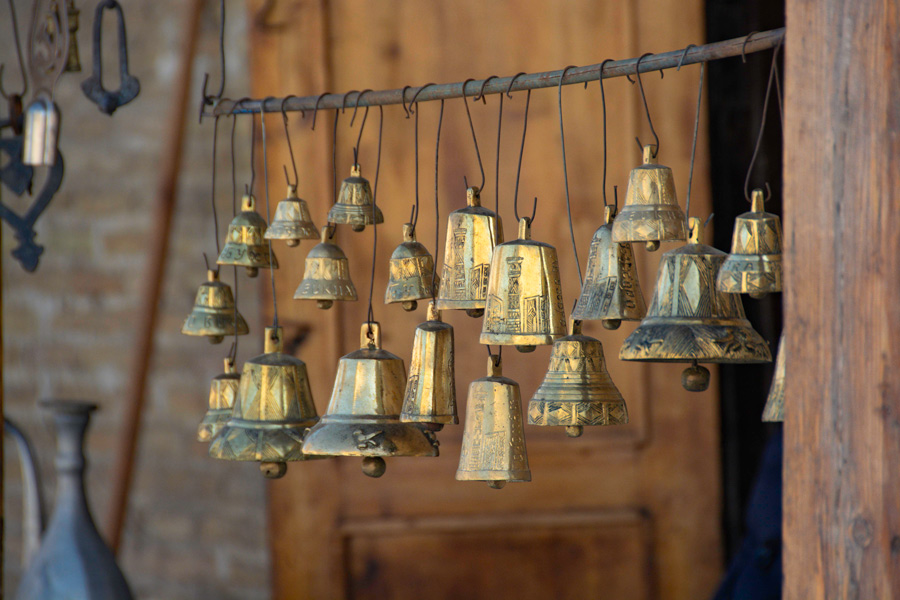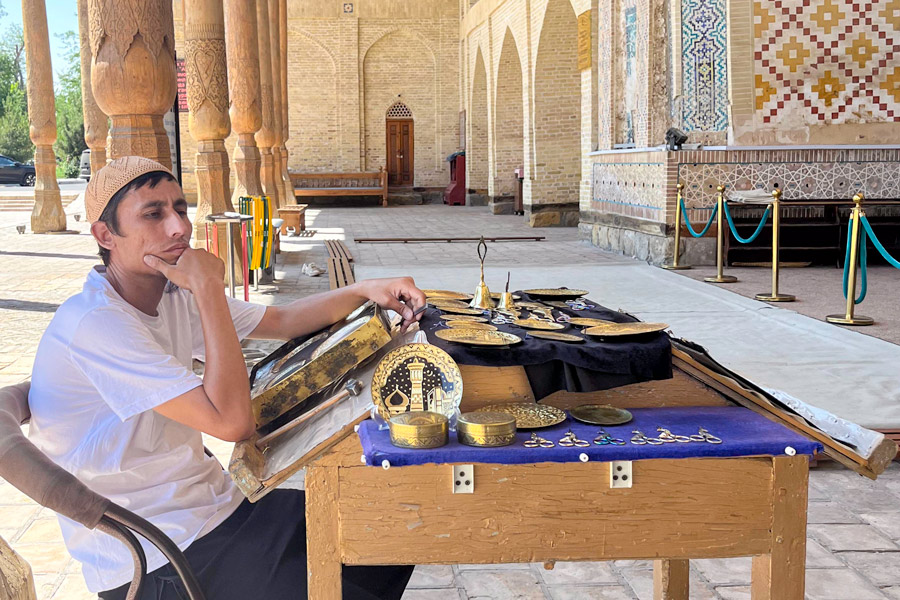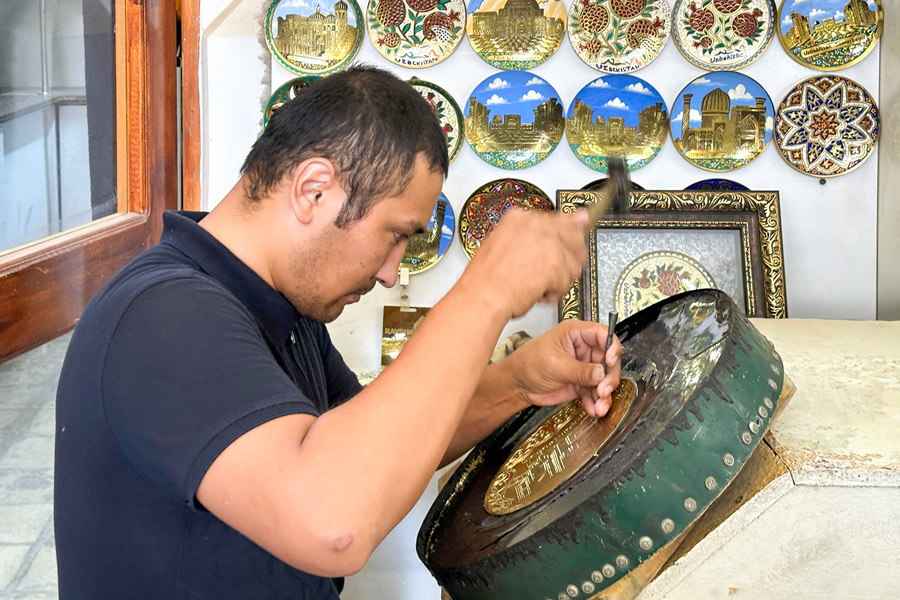
The art of manually decorating copper and brass objects with relief designs – copper embossing – is one of the oldest applied art forms still practiced in Uzbekistan today.
For centuries, embossed copperware from Uzbekistan, distinguished by its intricate ornamental motifs, has been prized throughout the East and along the trade routes of the Silk Road. Despite the transformations of modern life and the spread of industrial production, this centuries-old craft continues to hold an important place in the region’s artistic traditions.
Today, embossed copper pieces serve not only as functional items but also as distinctive interior accents and collectible artworks. Copper’s natural durability, enhanced by the development of a protective patina over time, ensures each handmade object remains both resilient and richly expressive – imbued with the unique touch of the artisan’s hand.
History of Uzbek Copper Embossing

The tradition of copper embossing in Uzbekistan stretches back centuries, sustained by hereditary artisans who carefully guarded their techniques and passed them down through generations. This intricate craft flourished over time and reached its artistic zenith in the 19th century.
It was during this period that local styles took distinct form, accompanied by a notable increase in the complexity of embossing techniques. Three principal schools emerged: Khiva, Bukhara-Samarkand, and Fergana-Tashkent.
- Khiva was renowned for delicately embossed floral patterns.
- The Bukhara-Samarkand style featured deep reliefs and the frequent use of stylized four-leaf clover motifs.
- In the Fergana-Tashkent tradition, artists placed special emphasis on the background – particularly evident in Fergana – while the Tashkent school favored large-scale ornamental forms.
Unique copper embossing traditions also developed in Karshi and Shakhrisabz, sometimes considered distinct regional styles in their own right.
During the era of the khanates (Khiva Khanate: 1511–1920; Bukhara Khanate: c. 1500–1785, followed by the Emirate of Bukhara until 1920; Kokand Khanate: 1709–1876), copper embossing was practiced on a range of metals: brass, copper, silver, and gold. The choice of material often reflected the social standing of the owner. Gold adorned the homes of khans and nobles; silver was highly prized as well. Copper and brass, though more affordable, were still regarded as luxury items. Possessing copper tableware – especially with elaborate ornamentation – was considered a mark of status, as the decorative work often cost more than the object itself.
Wealthier households commissioned customized pieces featuring personal dedications, ornamental inscriptions, and even miniature scenes. These items were further embellished with precious metals and colored pigments. A notable example is a multi-hued oftoba (self-boiler or samovar) with silver inlays, now housed in the Museum of the History of Uzbekistan.
The 20th century brought significant change. As machine production expanded, traditional copper embossing nearly vanished. Factory output replaced painstaking manual labor, accomplishing in hours what once took artisans weeks or even months. Historically, three specialists would contribute to a single piece: a foundryman, a coppersmith to shape the form, and a master who applied the ornamental design – making the process both laborious and costly.
Yet even in this challenging era, many artisans continued their work. Among them were the Khamidov family in Bukhara and the Madaliyev family, originally from Margilan, who later settled in Tashkent. Thanks to such families, the legacy of Uzbek copper embossing survived into the modern age.
By the late 20th century, the art began to experience a revival. Among today’s leading figures is Jurabek Sidikov, a hereditary master based in Bukhara whose work has earned him a place in the prestigious Homo Faber Guide, a global directory of exceptional artisans.
Why Copper Became Central to Uzbek Metalwork

Among the many metals available to artisans, copper has long been favored for crafting decorative household objects. Its physical properties and aesthetic appeal have made it a material of choice in Uzbekistan for centuries.
First, copper is both durable and malleable – an ideal combination for handwork. Unlike iron, which is too hard to ornament manually, or aluminum, which is too soft to hold fine contours, copper can be shaped into detailed, multi-layered patterns that retain their clarity over time. Some 19th-century Uzbek copper-embossed trays, for example, are still in everyday use today.
Secondly, copper has excellent heat retention – outperforming brass, bronze, and iron, and second only to silver. While silver conducts heat slightly better, the cost difference is considerable. Producing large silver vessels such as teapots, pitchers, or buckets would be prohibitively expensive, making copper the most practical and cost-effective alternative.
Copper’s visual qualities further enhance its appeal. With its reddish-gold luster, it draws the eye immediately. Over time, it develops a patina – a thin layer formed through oxidation –that lends the piece an aged, noble character. Depending on conditions, this patina may appear dark or greenish and often takes decades to form, making it a mark of authenticity prized by collectors.
Because patina is so valued, some contemporary artisans even imitate its appearance on new items. While authentic patina is harmless to touch, items with this finish are typically used for display rather than for serving food or drink.
A related material known as “yellow copper” – actually brass, an alloy of copper and zinc – has also become popular in Uzbek metalwork. In dim light, brass can resemble gold due to its vivid yellow hue and cool-toned brilliance. Often inlaid with colored glass or decorative stones, these pieces display an embossing style that appears particularly opulent and distinctive.
How Uzbek Artisans Create Embossed Copperware

The creation of embossed copper items is a time-intensive and meticulous process, combining technical skill with artistic vision. It begins with preparing and shaping a sheet of copper, which is then affixed to a base of bitumen – a dense, tar-like material derived from petroleum. This layer stabilizes the metal and absorbs vibrations during the embossing process.
Before any work begins on the copper itself, the artisan designs a preliminary sketch of the ornamentation. Here, the creative imagination and aesthetic sensibility of the craftsman are central. Each design is distinct, shaped by the hand that creates it, and cannot be exactly replicated.
The embossing then begins using several core techniques: kandakori (relief embossing), bosma (stamping), chizma (engraving with chisels), and shabaka (a perforation or slotting method). These approaches result in a rich, layered texture, and in some cases, openwork detailing that lends the piece a sense of delicacy and refinement. Remarkably, this intricate work is carried out using only the simplest tools – chisels, gravers (kalam), and hammers.
A key stage in the process is blackening, which heightens the contrast between the background and the raised ornament. Traditionally achieved through the use of fermented vegetable or fruit solutions such as vinegar, blackening today is most often produced using nitric acid, which reacts with heat to darken the recessed areas of the design.
The final steps are cleaning and polishing. Most items are coated with a layer of varnish to protect the surface, while some are further embellished with enamel for additional color and finish.
Traditional Copper Items of Uzbekistan

Copper has long been used to craft a wide variety of objects, from the everyday to the ornamental. While these items were originally intended for domestic use, today they are more often found as decorative accents in interiors of all styles. Gleaming copper jugs and trays complement traditional Oriental design, while aged, patinated pieces lend character to contemporary spaces.
Traditional Uzbek embossed copperware includes an array of tableware: tea jugs known as choydish, water jugs called oftoba, bowls for drinking and eating referred to as pialla or kosa, as well as bread bins, trays, lids, and other serving items. Uzbek copper samovars, introduced during the 19th century under Russian cultural influence, soon became integral household items. These were later adapted and richly decorated by Uzbek masters skilled in copper embossing.
Knives also occupy a special place in this tradition. Every part of a knife – blade, handle, and metal sheath – was often adorned with ornamental patterns and inlaid stones. Such knives were not only practical tools but also treasured as decorative pieces and prestigious gifts.
Beyond kitchenware, copper was widely used for household items: washing accessories such as dastsuy basins or lidded buckets, small storage boxes known as sandykcha, pen cases called kalamdon, incense burners, and hookahs all featured prominently in Uzbek homes. Each object was an opportunity for artisans to demonstrate their mastery of form and ornament.
Motifs and Meaning in Uzbek Embossed Copper
The most common motifs in Uzbek copper embossing are floral and plant-based patterns known as islimi, along with a variety of geometric designs. These are often complemented by stylized Arabic calligraphy bearing blessings for health and prosperity. Figurative imagery –especially animals– is used sparingly, but when it does appear, it carries poetic names such as “nightingale’s eye”, “snake’s trail”, or “butterfly”.
Smaller floral and animal motifs are typically enclosed within larger geometric structures –referred to as “brick”, “chain”, “triangle”, and other forms – creating a layered visual rhythm. Backgrounds are frequently filled with zigzags or cross-hatched lines to enhance contrast and texture.
By the late 19th and early 20th centuries, regional styles in Uzbek copper embossing had become more diverse. Craftsmen from Kokand introduced scenes featuring architectural monuments, while masters from Shahrisabz developed techniques for adding ornamental overlays embellished with precious stones. These innovations enriched the artistic vocabulary of copperwork and continue to inspire contemporary artisans today.

